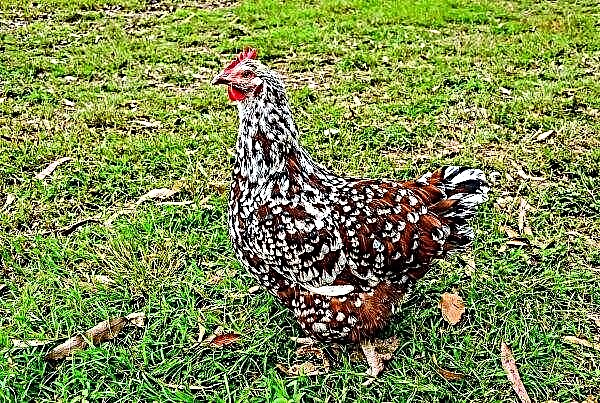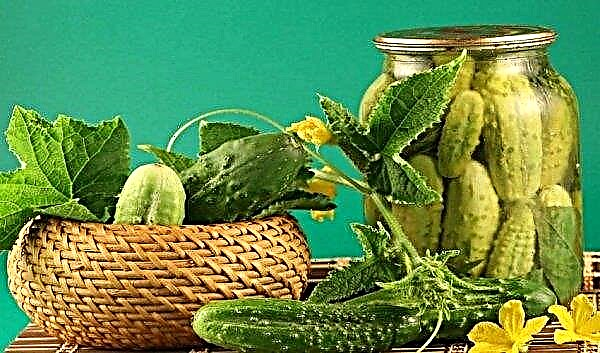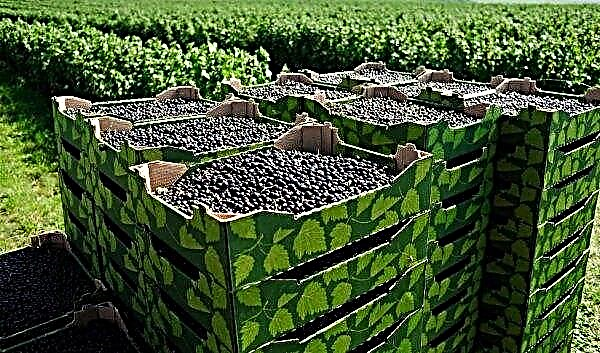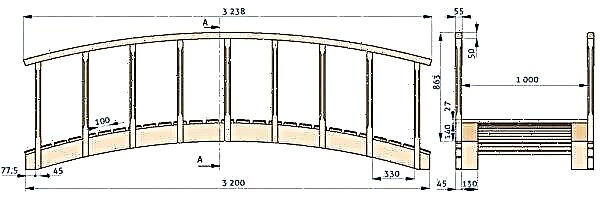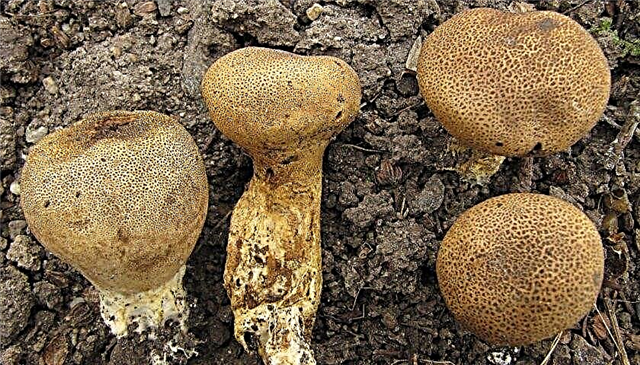Potato is perhaps the most versatile and popular product. Today, there are over 7,000 varieties of it. And among this diversity of many thousands, it is worth considering the Arizona variety, which compares favorably with its marketable and culinary qualities.
Description and characteristic
The variety was bred in 2013; it is the result of the work of the selection company AGRICO (Netherlands). It belongs to the early varieties of table type. The bush is medium-tall, leafy in type, the stems are straight, leafy, with a large broom during ripening. The leaves are large, green, closed. The root system is well developed.
The potato is oblong, oval, with small eyes and a yellow peel. On one bush 10-14 potatoes. The pulp is light yellow in color and contains 13–16% starch, which gives the potato a neat appearance during cooking and prevents strong cooking.
Taste qualities
The taste is good, the variety is culinary versatile, can be used in the preparation of a wide variety of dishes: mashed potatoes, fried potatoes with mushrooms, soups, baked potatoes, etc. Separately, there is no darkening of the pulp during cutting, mechanical damage and heat treatment.
Did you know? Potato was announced edible product only in 1772. On this step decided Paris Faculty of Medicine.
Ripening period and productivity
The ripening period of the variety is 70–80 days; for the sample, it can be collected after 55–60 days from the day of planting. The average yield ranges from 225–408 centners per hectare, the maximum yield - up to 577 kg / ha. Harvested under proper storage conditions is able to maintain its commercial quality in the range of 92–96%.
Advantages and disadvantages of the Arizona variety
- The undoubted advantages of the variety include:
- High yield.
- Good taste and culinary properties.
- Large sizes of potatoes and the absence of small tubers.
- A large percentage of keeping quality.
- High commercial quality - from 88 to 97% sales suitability.
- Excellent transportability and long-term saving ability.
- Resistance to the main ailments of potatoes.
- Cons of the variety are as follows:
- Weak resistance to late blight of tops and tubers.
- Weak resistance to common scab.
Planting and growing varieties
Agronomic requirements for cultivating Arizona varieties are not particularly difficult, but they should be considered in detail.
Optimal landing times
The most suitable landing time for Arizona is the end of April - the first half of May. The exact time of sowing depends on the weather and climatic conditions of a particular region.
Crop rotation rules
Potatoes will develop better in areas where onions, cabbage, various greens, legumes and winter crops, as well as perennial grasses, used to grow. But such predecessors on the site as sunflower, sorghum, tomatoes and other nightshade can negatively affect the potatoes - there is a risk of infection with the diseases that affect these crops.
But such predecessors on the site as sunflower, sorghum, tomatoes and other nightshade can negatively affect the potatoes - there is a risk of infection with the diseases that affect these crops.
Important! The same potato variety on one plot of land can be cultivated no more than 3–5 years in a row. Then the variety should be changed to a more resistant to disease.
Soil requirements
The most favorable soil for this variety is chernozem, sandy loam, sandy, loamy or clay soil, warmed up to a temperature of at least + 10 ° С. The potato area should be well lit by natural light, with the exception of possible shading from buildings, fences, trees, etc.
In the fall, the plot planned for Arizona’s landing is dug up and fertilized with organics. Immediately before planting, the soil is loosened to remove weeds. For acid normalization, wood ash can be introduced into the soil (the amount of ash applied depends on the acidity level of a particular soil at a normal soil pH for potatoes of 5-6).
Seed Potato Preparation
One of the main conditions for successful cultivation of a variety is the quality processing and germination of planting material:
- Healthy, medium-sized potatoes (from 50 to 70 g) are selected without any damage.
- To increase productivity, seed potatoes are pre-germinated - for 14-15 days it is placed in a warm and bright place.
- For a day after planting, potatoes are treated with a growth stimulant.
The use of such stimulants boosts the germination of tubers, increases productivity and resistance to pathogenic microbes and harmful insects. The most common stimulant is Epin. The Epin treatment allows seed potatoes to withstand late frosts to -5 ° C, promotes the formation of more powerful and stronger bushes, and also stimulates the rapid maturation of root crops.
Important! To process 200 tubers, one ampoule (0.25 g) of Epina diluted in 400 ml of water is enough.
On the day of planting, the material is sprayed with special protective agents, for example, the Matador fungicide, which protects the planting tubers from the Colorado potato beetle, late blight and alternariosis. For processing 30–35 planting potatoes, 30 ml of Matador diluted in 200 ml of water will suffice. For high-quality spraying, the planting material is laid out in a single layer and sequentially processed first from one side, and then from the back.
Landing technology
There are many options for planting potatoes, but all of them must contain the basic requirements:
- On the day of planting, the soil is treated with potassium permanganate for disinfection.
- The distance between the tubers is 0.2–0.3 m.
- The distance between the rows is from 0.6 to 0.7 m.
- The depth of the grooves (in light soils - holes) - in the southern regions up to 15 cm, in the northern - up to 20 cm.
Variety care after planting
Caring for Arizona is basically no different from caring for the rest of the potato varieties - watering, fertilizing, cultivating the soil.
Did you know? To popularize potatoes in France, the wife of Louis XVI (1774–1792), Marie Antoinette, decorated her outfits with fresh flowers of this plant.
Fertilizer
The need for feeding potatoes is due to its weak root system, many large tubers, as well as the fact that valuable materials are removed from the soil along with the harvested crop. The main purpose of the fertilizer is to replenish the content of nutrients in the soil. When cultivating this potato variety, fertilizing is recommended three times per season:
When cultivating this potato variety, fertilizing is recommended three times per season:
- Initial feeding. It is produced by nitrogen-containing substances after the emergence of plants. The signal of the nitrogen deficiency of the plant is its pale foliage. The solution is used: 500 ml of mullein and 15 g of urea diluted in 10 l of water. Consumption: for each bush - 500 ml of solution.
- Second feeding. During the formation of the buds. Potash fertilizers are introduced: 15 g of potassium sulfate, 15 g of double superphosphate and 0.5 cup of wood ash diluted in 10 l of water. Consumption: for each bush - 500 ml of solution. Such top dressing favors the formation and growth of tubers.
- Third feeding. Mineral organic. Contributed 20-25 days before harvest. 30 g of superphosphate and a glass of slurry are diluted in 10 l of water. Consumption: per bush - 50 ml of fertilizer.
Watering
Watering is done in hot weather. The first time it is carried out after the appearance of stem processes 5-10 cm above the ground in the center of the bush. Water consumption - 3-4 liters per plant. Since Arizona does not accept sudden changes in humidity, fractional watering is effective: at first, only part of the required volume of water is poured under the bush, after its absorption, the rest of the liquid is poured. Thus, uniform soil moisture is produced. Before buds are formed, planting is irrigated once a week.
Important! Water for irrigation in any case should be warm, previously defended in the sun.
When the first peduncles appear, watering increases to two times a week at a water flow rate of 12-15 l per bush. The liquid is poured in small portions in the morning before sunrise or late in the evening. The best way is drip irrigation, if there is no such possibility, water must be let through the grooves from the hose or by sprinkling. When the first signs of foliage wilt appear, watering continues, but with a dose reduction - by 1 bush 3 l of water. The complete drying of the stems is a sign of crop maturity and a signal to stop watering.
Weeding
Weeding is carried out in order to create and maintain the necessary conditions for the development of potato tubers, namely:
- Air access.
- Moderate soil moisture.
- Giving soil the necessary softness and loosening.
Hilling
Hilling or tacking moist, with small clumps of soil to the bottom of the plant with its simultaneous loosening is done twice a season:
- First tipping - with the growth of potato stems 10–20 cm above the ground.
- Re-roll - after 14–20 days. At the second hilling, the ground is thoroughly loosened, and in the form of knolls it is rolled to the stems.
Important! Tumbling is done exclusively on moist soil. In drought, grafting is done after artificial irrigation.
In arid regions, stalling prevents overheating of the soil and contributes to the preservation of moisture in it, and in areas with a cool and rainy climate, earthing up, loosening the soil, ensures proper aeration of the soil.
Fighting diseases and pests of the variety
Despite its good resistance, the Arizona variety is still susceptible to defeat by some diseases and pathogenic insects.
Possible diseases:
- Late blight or brown rot. It represents the greatest danger, since Arizona has a low resistance to this disease. The most favorable time for the spread of the disease is warm and humid weather, in which the defeat of the entire potato planting is possible. The main sources of late blight are infected soil and tops, affected neighboring plants, especially solanaceous plants. The primary sign of the disease is darkened lower leaves. Over time, the entire plant is completely affected - its aboveground and underground parts. Ways of struggle: upon detection of the first signs - treatment with a fungicide landing (the most effective are Skor, Ditan, Bravo and Reglon Super). Prevention: observance of crop rotation standards, exclusion of Arizona planting in lowlands, prevention of thickened rows, timely hilling of bushes.

- Common scab. A fungal ailment that develops in dry, hot weather and affects the skin of potatoes. Signs of a lesion are the appearance of ulcers on the potatoes of various shapes and sizes, with a strong lesion merging into a continuous crust. The presentation of the vegetable is lost, its taste is deteriorated, the level of starch is reduced, and the shelf life is reduced. Methods of control: the use of physiologically acidic fertilizers (manganese sulfate, ammonium sulfate). Prevention: careful rejection of affected potatoes during planting, regular watering of the soil.

Due to its high resistance, the variety successfully resists the vast majority of pests, but the Colorado potato beetle is a danger to it. Wintering in the ground, with the onset of a warm pore, it appears on the surface. The insect, along with its larvae, eats the greenery of the culture, thereby destroying the bush.
Control measures: with a small landing - manual collection followed by the burning of pests; if manual collection is not possible - spraying with bio-agents (Agrovertin, Bikol, Colorado, Karbofos, Regent are used), as well as treatment of bushes with folk remedies - a solution of birch tar (100 g for 10 l of water) tar).
Features of harvesting and storage of crops
55-60 days after planting, Arizona can already be dug for sampling, and another 10-15 days can start harvesting. However, a week before harvesting, to saturate the tubers with nutrients and simplify the harvest, potato tops are mowed. Digging is carried out directly in dry weather. Harvested crops are sorted: the best potatoes are laid as seed for the next season, and tubers that have any damage or are affected by diseases are discarded. If the ambient temperature is not too high, for drying, the dug potatoes are left in the garden for one to two hours. For long-term storage, the crop is transferred to the cellar. The rules and storage conditions for Arizona varieties do not differ from the usual storage conditions for potatoes. Due to its good shelf life, from 92% to 96% of potatoes laid for seasonal storage retain their commercial and taste qualities.
If the ambient temperature is not too high, for drying, the dug potatoes are left in the garden for one to two hours. For long-term storage, the crop is transferred to the cellar. The rules and storage conditions for Arizona varieties do not differ from the usual storage conditions for potatoes. Due to its good shelf life, from 92% to 96% of potatoes laid for seasonal storage retain their commercial and taste qualities.
Useful tips gardeners
To get a good harvest when growing Arizona varieties, along with observing the "academic" standards of agricultural technology, it is worthwhile to heed the recommendations of experienced gardeners:
- Landing Arizona is better during the waning moon. Many gardeners believe that planting should be commensurate with the lunar calendar, and with a waning moon, plant everything that grows down - bulbs, root crops, including potatoes, and if the aerial part of the plant is important - then plant it with the growing moon.
- Fertilizer Combination and tumbling bushes is the most optimal.
- The need for additional watering determined as follows: for this it is necessary to lower the palm into the ground and, if the soil is dry below the level of the fingers, the potatoes should be watered.
- To protect the site from weeds and retain moisture, soil after watering need to mulch.
- On a bright sunny day, dug up it is better to place the crop for drying under a canopy - this will save the potatoes from burns.
So, the Arizona potato variety is of high quality and easy to care for. With the strict implementation of all agricultural standards, he is able to please a quick and plentiful harvest of tasty and culinary versatile potatoes.




